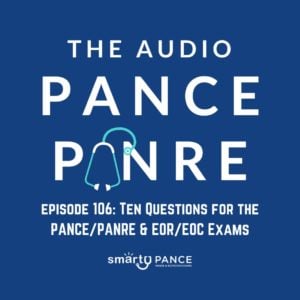Listen to Podcast Episode 106: Ten PANCE, PANRE, and Rotation Review Questions + Review of Adrenal Insufficiency
If you can't see the audio player, click here to listen to the full episode.
 Welcome to episode 106 of the Audio PANCE and PANRE Physician Assistant/Associate Board Review Podcast.
Welcome to episode 106 of the Audio PANCE and PANRE Physician Assistant/Associate Board Review Podcast.
Join me today as we cover ten board review questions for your PANCE, PANRE, EOR, and EOC exams.
Links from today's episode:
- Sign up for our new PANCE and PANRE Test Taking Masterclass
- Sign up for the Entire Blueprint Email Series
- Follow Smarty PANCE and The Daily PANCE Blueprint on Instagram and Facebook
- Review adrenal insufficiency and adrenal disorders
- Join the Smarty PANCE Member's Community, then sign up for a study group to get updates about upcoming webinars.
I hope you enjoy this free audio component of the examination portion of this site. Smarty PANCE includes over 2,000 interactive board review questions, along with flashcards, ReelDx cases, integrated Picmonics, and lessons covering every blueprint topic available to all Smarty PANCE members.
- You can download and listen to past FREE episodes here, on iTunes, Spotify, Google Podcasts, Stitcher, Amazon Music, and all podcasting apps
- You can listen to all the latest episodes, take interactive quizzes, and download more resources on each episode page.
Interactive exam to complement today's podcast
1. A 22-year-old female with an unknown past medical history presents to the ER with a prolonged seizure lasting more than 5 minutes per EMS. Her airway was supported, and IV access was obtained en route to the ER. Her blood glucose is 120. Her vitals are stable, and laboratory studies are relatively unremarkable. Which of the following would be an appropriate medication to give to this patient?
A. Calcium gluconate
B. Propofol infusion
C. Lorazepam
D. Clonidine
E. Narcan
Smarty PANCE Content Blueprint Review:
Covered under ⇒ PANCE Blueprint Neurology ⇒ Seizure disorders ⇒ Status epilepticus
Also covered as part of the Internal Medicine EOR and Emergency Medicine EOR topic list
2. A 41-year-old male presents to the ER after a construction accident that left him with severe right eye pain and decreased visual acuity. On a physical exam, you notice a teardrop-shaped pupil. Which of the following is the most likely diagnosis?
A. Globe rupture
B. Acute angle-closure glaucoma
C. Retinal detachment
D. Corneal laceration
E. Metallic foreign body
Smarty PANCE Content Blueprint Review:
Covered under ⇒ PANCE Blueprint EENT ⇒ Traumatic disorders ⇒ Globe rupture
3. A 45-year-old male veteran presents to your clinic complaining of the following for 4 months: problems with concentration, difficulty staying asleep, persistent negative state, inability to remember events that happened while he was in Iraq, feelings of detachment from others, avoidance of other veterans, and distress when seeing violence on the TV. He denies hallucinations. He has been a veteran for 5 years. Which of the following is the most likely diagnosis?
A. Acute stress disorder
B. Cyclothymic disorder
C. Brief psychotic episode
D. Derealization/depersonalization disorder
E. Post-traumatic stress disorder
Smarty PANCE Content Blueprint Review:
Covered under ⇒ PANCE Blueprint Psychiatry ⇒ Trauma and stressor-related disorders ⇒ Post-traumatic stress disorder
Also covered in Emergency Medicine EOR, and Family Medicine EOR Blueprint
4. Which of the following clinical findings would you likely expect in a patient with primary adrenal insufficiency?
A. Hypernatremia, hypokalemia, tired
B. Moon facies, depression, bruising
C. Polyuria, polydipsia, intense thirst
D. Fatigue, hyponatremia, hyperpigmentation
E. Hypothermia, bradycardia, goiter
Smarty PANCE Content Blueprint Review:
Covered under ⇒ PANCE Blueprint Endocrinology ⇒ Adrenal Disorders ⇒ Primary adrenal insufficiency
Also covered as part of the Family Medicine EOR, Internal Medicine EOR, and Emergency Medicine EOR topic list
5. A 42-year-old male presents with right upper extremity numbness, dysesthesia, weakness, and arm pain with exertion. The symptoms are aggravated by activity and reaching overhead. Which of the following is the most likely diagnosis?
A. Thoracic outlet syndrome
B. Median nerve compression
C. Biceps tendon rupture
D. Carpal tunnel syndrome
E. Subclavian steal syndrome
Smarty PANCE Content Blueprint Review:
Covered under ⇒ PANCE Blueprint Musculoskeletal ⇒ Spinal Disorders ⇒ Thoracic outlet syndrome
6. A 34-year-old female is diagnosed with immune thrombocytopenic purpura. What is NOT a known cause or risk factor of ITP?
A. Hepatitis C
B. Systemic lupus erythematosus
C. HIV
D. COVID-19
E. Warfarin
Smarty PANCE Content Blueprint Review:
Covered under ⇒ PANCE Blueprint Hematology ⇒ Coagulation Disorders ⇒ Thrombocytopenia ⇒ Idiopathic thrombocytopenic purpura
Also covered as part of the Internal Medicine EOR topic list
7. A 72-year-old African American male presents to the clinic complaining of weight loss, fatigue, and back pain. During the physical exam, you palpate an enlarged, irregular, nodular prostate. Which of the following is the most important risk factor for the development of this most likely diagnosis?
A. Genetic factors
B. Ethnicity
C. Increasing age
D. Obesity
E. High meat diet
Smarty PANCE Content Blueprint Review:
Covered under ⇒ PANCE Blueprint Genitourinary ⇒ Neoplasms of the Genitourinary System ⇒ Prostate cancer
Also found in Internal Medicine EOR PAEA blueprint
8. A 52-year-old female with a history of previous abdominal surgeries presents to the ER with nausea, emesis, abdominal pain, and inability to pass gas. On physical exam, you notice abdominal distention and auscultate high-pitched tinkering sounds in the upper abdominal quadrants. Which of the following is the most likely diagnosis?
A. Mesenteric ischemia
B. Diverticulitis
C. Gastric ulcer perforation
D. Small bowel obstruction
E. Ischemic colitis
Smarty PANCE Content Blueprint Review:
Covered under ⇒ PANCE Blueprint GI and Nutrition ⇒ Diseases of the Small Intestine ⇒ Small bowel obstruction
Also covered as part of the Family Medicine EOR, Emergency Medicine EOR, and General Surgery EOR topic list
9. Which of the following is the most common cause of acute cor pulmonale?
A. Cardiac tamponade
B. Pulmonary embolism
C. Mitral regurgitation
D. Congestive heart failure
E. Portopulmonary syndrome
Smarty PANCE Content Blueprint Review:
Covered under ⇒ PANCE Blueprint Pulmonary ⇒ Pulmonary Circulation ⇒ Cor pulmonale
10. A 25-year-old female with no past medical history presents with nausea, emesis, and pelvic pain. She is normotensive, afebrile, and slightly tachycardic (HR 102 bpm). On physical exam, you palpate an ovarian/pelvic mass. Beta-hCG is negative. The pelvic US is pending. Which of the following is the most likely diagnosis?
A. Ectopic pregnancy
B. Appendicitis
C. Pelvic inflammatory disorder
D. Ovarian torsion
E. Placenta abruption
Smarty PANCE Content Blueprint Review:
Covered under ⇒ PANCE Reproductive System Blueprint ⇒ Ovarian Torsion
Also covered as part of the Women's Health PAEA EOR topic lists
This podcast is available on every device!
You can download and listen to past FREE episodes here, on iTunes, Spotify, Google Podcasts, Stitcher, Amazon Music, and all podcasting apps.
Download Interactive Content Blueprint Checklists for the PANCE, PANRE, EOR, and PANRE-LA
Follow this link to download your FREE copy of the PANCE/PANRE/EOR Content Blueprint Checklists.
Print it up and start crossing out the topics you understand, marking the ones you don't, and making notes of key terms you should remember. The PDF version is interactive and linked directly to the individual lessons on Smarty PANCE.
Smarty PANCE is not sponsored or endorsed by, or affiliated with, the National Commission on Certification of Physician Assistants.





